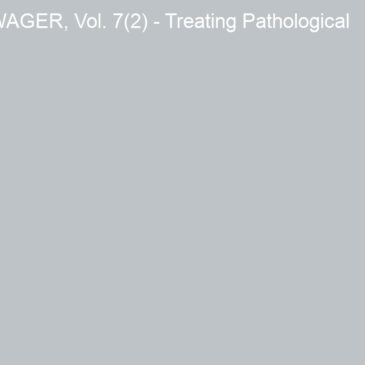Depending upon the severity of the disorder, a patient’s willingness to seek help, insurance regulations, and assorted other factors, clinicians usually channel individuals into one of three basic treatment alternatives: inpatient, outpatient, and inpatient/outpatient hybrid programs. This WAGER describes a treatment program that may well anchor one end of the treatment continuum: a UK problem gambling residential treatment program, described by Griffiths, Bellringer, Farrell-Roberts, & Freestone (2001), the Gordon House Association (GHA).
Griffiths et al. (2001) reported on an all-male in-patient treatment program that could last for approximately nine months, depending upon patient progress. They described the initial assessment period, three treatment phases of the residential program, and the relapse prevention and after-care outpatient services provided The links below provide summaries of the phases described by Griffiths et al. (2001).
Initial Assessment
- Time period: weeks 1 to 2
- Assessment via initial application form, face-to-face interview, and visit to GHA
- Write report outlining nature of the problem and likely causes and consequences
- Determine appropriateness of residential treatment
- For those admitted, identify treatment goals
- Administer SOGS, DSM-IV, and the General Health Questionnaire (GHQ)
Phase One: Coping With Today
- Time period: weeks 3 to 14
- Encourage the development of new leisure interests
- Time management skill training
- Re-establish a sense of stability in the gambler’s life
- Encourage the development of support networks with other problem gamblers
- Time period: weeks 15 to 26
Phase Two: Coping With Yesterday
- Psychodynamic group work
- Individual cognitive-behavioral counseling
- Identify underlying cause of gambling problem
- Referrals for problems out of the scope of gambling
- Encourage GA attendance
- Encourage familial reconciliation and “giving back”
Phase Three: Coping With Change
- Time period: weeks 27 to 38
- Life skills development (career, housing, etc)
- Preliminary steps toward independent living
Phase Four: Coping With Tomorrow
- Time period: weeks 39 to 50
- Relapse prevention program
- Seminars on: “resettlement, survival, employment, and social skills”
- Practical steps toward independent living and resettlement
- Intensive outreach support for first 3 months after leaving residence
Phase Five: Coping On My Own
- Time period: ongoing
- Reduced outreach support, but continued contacted is encouraged
- Reunion meetings and newsletters
The development of an inpatient program that takes nine months to complete testifies to the perceived seriousness of problem/pathological gambling in the UK. Interestingly, the program is only open to men. It is unclear whether this treatment or a similar clinical strategy would be appropriate for women. Long-term inpatient treatment includes a number of costs (e.g., financial, social, time) to the patient. These costs can make this approach socially invasive with an associated potential for adverse consequences. Furthermore, the likelihood of complete insurance coverage for a nine month residential gambling treatment program in other countries is very low given research findings suggesting that outpatient treatment can be as effective as inpatient treatment for other addictive disorders (McKay, Cacciola, McLellan, Alterman, & Wirtz, 1997; McKay, 1992), and that brief interventions can be successful in treating problem gambling (e.g. Hodgins, Currie, & el-Guebaly, 2001).
Griffiths et al. (2001) provided a description of the GHA program rather than an evaluation. The authors provided no empirical information on the effectiveness of the program. The anecdotal evidence presented was not sufficient to support a recommendation of the program. The relatively high cost of inpatient and residential treatment demands analyses of the cost/benefit ratio as well as explorations of whether costs can be reduced by exchanging some of the inpatient treatment with equally effective brief treatments administered on an outpatient basis. Future issues of the WAGER will present examples of pathological gambling treatment programs with markedly different schedules; brief outpatient therapies, and combined inpatient-outpatient programs.
References
Giuliani, D., & Schnoll, S. H. (1985). Clinical decision making in chemical dependence treatment: A programmatic model. Journal of Substance Abuse Treatment, 2(4), 203-208.
Hodgins, D. C., Currie, S. R., & el-Guebaly, N. (2001). Motivational enhancement and self-help treatments for problem gambling. Journal of Consulting and Clinical Psychology, 69(1), 50-57.
McKay, J. R., Cacciola, J. S., McLellan, A. T., Alterman, A. I., & Wirtz,
P. W. (1997). An initial evaluation of the psychosocial dimensions of the American Society of Addiction Medicine criteria for inpatient versus intensive outpatient substance abuse re-habilitation. Journal of Studies on Alcohol, 239-252.
McKay, J. R., McLellan, A.T., & Alterman, A.I. (1992). An evaluation of the Cleveland criteria for inpatient treatment of substance abuse. American Journal of Psychiatry, 149, 1212-1218.




